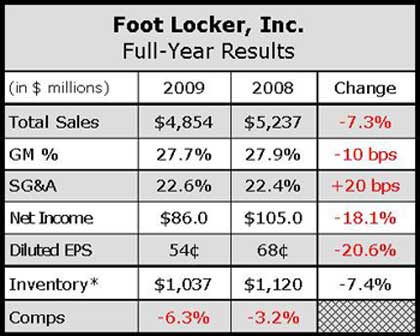Foot Locker, Inc. reported that 2009 fourth quarter comp store sales decreased 2.3%, dragged down by a mid-double-digit decline at its U.S. store operations. But with strong demand for toning and technical running shoes, the worlds largest athletic-specialtyretailer is seeing an improving sales trend in both the U.S. and international markets, marked by a same-store increase in January that accelerated into February.
For the fourth quarter, comps declined high-single digits in November and low-single digits in December before increasing low-single digits in January. Januarys comps reflected a high-single digit international gain and flat U.S. comps. Net sales in Q4 inched up 0.6% to $1.33 billion. Excluding the impact of foreign currency fluctuations, sales decreased 2.9%.
In February, comps improved mid-single digits in both domestic and international markets, as well as in its e-commerce business.
Management also noted that February is its most difficult monthly comparison.
The athletic shoe retailer posted a net profit of $23 million, or 14 cents per share, in the period versus a year earlier loss of $125 million, or 81 cents per share, when the company was hit by a steep impairment charge. Excluding special charges, earnings reached $39 million, or 24 cents a share, equal to the $39 million, or 25 cents, in the prior-year period. Restructuring moves in the latest period included the closing of 106 stores and elimination of 120 corporate and divisional field and home office positions, as well as the consolidation of its Foot Locker, Lady Foot Locker, Kids Foot Locker and Footaction operations under one management structure; and changing its merchandise aging standard to be aligned with the company’s new apparel strategy.
On a conference call with analysts, Foot Locker Chairman and CEO Ken Hicks said athletic footwear sales in the U.S. declined low-single digits in the quarter while apparel and accessories were down double digits. A small comp gain was seen in men’s footwear, but the division posted a low-single digit decline in women’s footwear, and a mid-single digit decline in kids footwear.
On the bright side, Hicks said Foot Locker began to see two important fashion trends emerge that they believe bode well for the company.
First, he said the toning category contributed to the higher sales and is breathing new life into the women’s business. Also, both men’s and women’s technical running shoes are quickly gaining momentum.
Solid sales gains in running footwear were led by Nike, Asics, New Balance and Puma. In marquee basketball, Jordan Retros, as well as Griffey, Kobe and LeBron-endorsed footwear, posted strong gains.
In womens footwear, strong gains were generated by Reebok Easy Tone and Skechers Shape-ups and the overall toning category contributed to the athletic look regaining its popularity, according to Hicks. Strong gains in women’s running shoes, in both higher-priced technical, and mid-priced value zones, were led by Asics, Nike, and New Balance.
In total, average footwear selling prices in the U.S. increased low-to-mid single digits, reflecting its continuing mix shift toward higher-priced footwear, and a lower markdown rate.
The steep apparel decline reflected a very tough selling climate and came despite liquidation efforts. Said Hicks, Clearly, improving our apparel business is one of our significant sales and profit opportunities for our company and will be an important strategic objective that will be a focus for us over the next several years.
Internationally, comps in Europe increased mid-single digits in both footwear and apparel. In January, comps rose nearly double digits. By category, Europes strongest increases were seen in basketball, which Hicks said is becoming a more significant piece of our business in Europe. Sales at Foot Locker Canada declined slightly though it increased during January and the region generated a small profit increase due to markdown and expense disciplines. Asia-Pacifics comps were down high-single digits and profits fell although it reflected tough year-ago comparisons.
At its Footlocker.com/Eastbay division, profit was flat with last year, with a slight comp increase. However, the divisions profit margin rate at the core Foot Locker.com/East Bay business remained strong in the low teens. Sales results at its two CCS action sports test stores declined mid-single digits, but Hicks said Foot Locker continues to learn a great deal from CCS and is expanding the test to another ten stores this year.
Fourth quarter margins improved by 10 basis points versus last year, reflecting a 20 basis point improvement in merchandise margins due to less markdown activity. SG&A expense rose to 22.3% of sales from 21.9% a year ago but was favorable to each of the first three quarters.
Foot Locker ended the year with 3,500 stores, reflecting 38 new stores and 179 closed stores for the year. It plans to open approximately 40 new stores this year and close approximately 150.
















